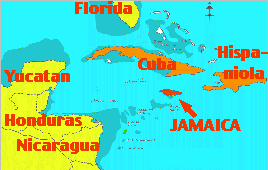 Soon after its
emergence, Jamaica started to experience colonization by biotas
that island-hopped via exposed shoals from Central America along
the Nicaraguan rise as well as from the neighboring islands of Cuba
and Hispaniola and North America. The darker-blue areas on the map
above show 200m depths which would have been dry about 10,000 years
ago (at the end of the last glaciation period (see Lack 1976). The ancestors of all present-day
species required the abilities to disperse overwater and,
consequently, species diversity is typical of an oceanic island.
Compared to a mainland area of comparable size and latitude, the
species richness of Jamaica's biota is depauperate, with many
taxonomic groups of poor dispersal ability absent from the biota.
However, for the successful colonizing species, Jamaica's size and
diverse physical features presented a wide range of microhabitats
that facilitated within-island radiation and speciation. The
present composition of species, both floral and faunal, represents some of the highest
rates of endemism in the world, recognized particularly for ferns,
birds, reptiles, frogs and land snails.
Soon after its
emergence, Jamaica started to experience colonization by biotas
that island-hopped via exposed shoals from Central America along
the Nicaraguan rise as well as from the neighboring islands of Cuba
and Hispaniola and North America. The darker-blue areas on the map
above show 200m depths which would have been dry about 10,000 years
ago (at the end of the last glaciation period (see Lack 1976). The ancestors of all present-day
species required the abilities to disperse overwater and,
consequently, species diversity is typical of an oceanic island.
Compared to a mainland area of comparable size and latitude, the
species richness of Jamaica's biota is depauperate, with many
taxonomic groups of poor dispersal ability absent from the biota.
However, for the successful colonizing species, Jamaica's size and
diverse physical features presented a wide range of microhabitats
that facilitated within-island radiation and speciation. The
present composition of species, both floral and faunal, represents some of the highest
rates of endemism in the world, recognized particularly for ferns,
birds, reptiles, frogs and land snails.
There are also some quite remarkable and advanced examples of brood care which have presumably
evolved in response to the difficult environment., and we see many
of these in the Cockpit Country.
Conservation of biological diversity requires a portfolio of a broadly-representative base of globally important ecosystems. The potential importance of particular species and ecosystems rich in endemism are recognized further. Within representative ecosystems, attention is given to:
Although there is no universally agreed classification for establishing the global importance of protected areas, and it frequently is difficult to attach a numerical value for intrinsic qualities of biodiversity to assess comparative economic worth, there are several ecologically important factors to be considered
In addition to nonquantitative ecological rankings, individual species or ecological communities can be recognized as: